Uncover Colmar's vibrant flavors and culinary gems with our expert guides. Plan an unforgettable trip now!
Read more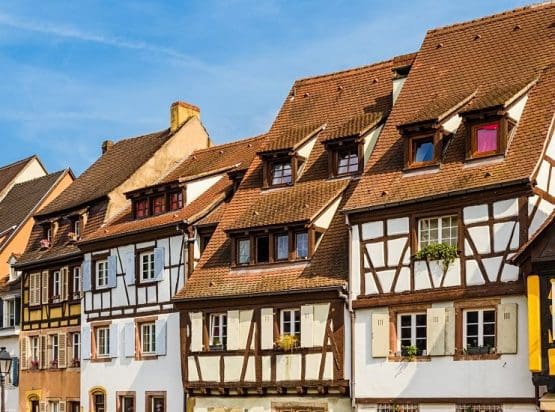
EXPLORE ALL OUR EXPLORE THE BEST FRENCH WINE REGIONS: A COMPLETE GUIDE
Last updated: April 4, 2025
Alsace is unlike any other French vineyard. Its history, scenery, and cultural heritage are unique. Nestled between the Vosges Mountains and the Rhine River, Alsace has long been a melting pot of French and Germanic influences. The region’s signature grape variety, Riesling, most obviously demonstrates this. Indeed, no other appellation in France champions this misunderstood grape, although it is ubiquitous across the border in Germany. Popularly known as the land of storks’ nests and Instagrammable half-timbered houses, Alsace is France’s leading producer of unoaked whites.
Wine tourists have long adored the place; its chocolate-box villages, delicious gastronomy, and undulating landscape are irresistible. But this vineyard is far more than tourist-centric—universally acclaimed Alsatian whites are enjoyed worldwide. Renowned for superlative still and sparkling wines, Alsace also dabbles in pungent and velvety Pinot Noir. Grand Cru Alsatian Riesling is unmissable. However, it is merely the tip of a large iceberg. Discovering Alsace will take a while.
Discover More About French Wine
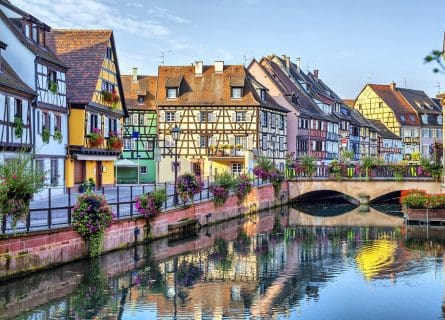
Alsace has long been a European melting pot, starting with the arrival of the Celtic Gauls in the 1st millennium BC. This proud culture fought bravely against the superior forces of Julius Caesar during the Roman Gallic Wars.
However, Caesar’s armies ultimately emerged victorious in 50 BC. The Western Roman Empire absorbed Gaul (modern-day France), and it remained an important part of the Roman administration for over four centuries. The Romans planted vines across the Alsatian landscape, including plots that eventually became classified as the region’s venerable Grand Crus. Yet from the 4th and 5th centuries AD, Germanic tribes destroyed much of the Roman legacy.
Frankish Rule and Fragmentation
Meanwhile, the Franks seized power after the fall of the Western empire in AD 476, pushing the Visigoths into Spain. Successive Frankish dynasties provided much-needed stability and political leadership in the period following the Dark Ages. However, France became politically fragmented when their line died out in the late 900s.
Nevertheless, the late Middle Ages were a period of economic prosperity and cultural vitality, led by the Frankish Capetian dynasty. Alsace looked to France’s armies to restore order during the Reformation and the ensuing Wars of Religion. Opposing Catholic and Protestant factions raised hell across the region, with atrocities committed on both sides.
After the Thirty Years War (1618-48), the Treaty of Westphalia awarded most of Alsace to the French crown. Meanwhile, Louis XIV’s unparalleled ambition transformed France into a militarily and intellectually European superpower. In the Age of Enlightenment, French culture and institutions were the envy of its neighbors.
Alsace in Times of Conflict and Change
Alsace was a vital part of the French wine economy by the time of the French Revolution. There was little regional desire for reassimilation into the last vestiges of the Holy Roman Empire. Of course, the Germans felt differently. The passage of time did little to dampen their appetite for reabsorbing a lucrative piece of real estate. From their perspective, Elsass (their name for Alsace) had never been genuinely French.
Alsace’s Shifting National Allegiances
Unfortunately, the Franco-Prussian War of 1870-71 did not end well for the French state. The Treaty of Frankfurt saw Alsace become a sovereign German territory. However, the nation’s defeat in WW1 returned the region to French control.
The Nazis annexed Alsace in the 1940s. However, France regained control of it after the Second World War. These political machinations did no favors to Alsace’s wine industry. Constant shelling and the horrors of Trench Warfare destroyed many vineyards in the First World War.
Clos Ste-Hune: A Legendary Vineyard in Alsace
However, the second half of the 20th century saw many positive changes in Alsace. In 1983, the region embraced the Burgundian paradigm of classifying terroir with its inaugural Grand Cru appellation. These bold projects set out to delineate Alsace’s best terroirs and vineyards; Jean Hugel was one of the winemakers tasked with undertaking the research, selecting the finest plots for promotion to Grand Cru status.
The most famous climat (vineyard site) is undoubtedly Clos Ste-Hune. Long owned by the Trimbach family, the word ‘clos’ refers to a self-contained vineyard, part of the Rosacker Grand Cru. Journalists, buyers, and critics regard Clos Ste-Hune as one of the world’s greatest expressions of the noble Riesling grape. “The Romanée-Conti of Alsace.”
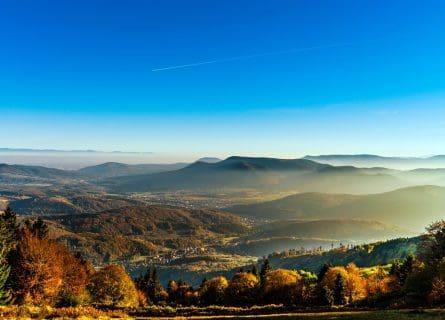
Alsace, with its charming villages and picturesque landscapes, boasts a spectacular topography. The vineyards are located east of Paris, about 60 miles north to south. To the west is the Vosges Mountains, the most important element in shaping Alsace’s wine culture. Indeed, thanks to the Vosges natural rain shadow, varieties like Pinot Noir and Pinot Blanc can ripen in northeastern France; sunshine hours are high during the growing season, and rainfall is low.
To the east of the Vignoble is the Rhine and the German border. Diurnal temperature variation and a temperate climate are responsible for the region’s famously fresh and crunchy fruit flavors – conscientious growers in Alsace seldom produce flabby wines. Alsace’s passionate growers take full advantage of these favorable natural conditions, a true blessing for their vineyards.
Alsace’s Winemaking Landscape
The area under vine stretches west of Strasbourg in the north to Mulhouse in the south, with the heart of the region centered around the town of Colmar. Strasbourg is the administrative capital of Alsace, with excellent transport links to the surrounding villages.
Traditionally, Alsace has been divided into two subregions: Bas-Rhin and Haut-Rhin further south. The latter is where you can find the greatest concentration of top villages and vineyard sites, particularly Grand Crus. In some respects, the region resembles the Cote d’Or in Burgundy, as the finest sites are on the slopes of the Vosges, with well-drained, meager soils.
A Tapestry of Terroirs: Alsace’s Diverse Soils
Meanwhile, Alsatian terroir ranks among France’s most heterogeneous, encompassing schist, granite, clay-limestone, sandstone, and volcanic soils. Consequently, Alsace offers a wide spectrum of styles, with suitable terroirs for almost every grape variety. For example, Riesling has a strong affinity with granite terrain, while Pinot Noir thrives on calcareous marls.
Grand Cru Elegance: Alsace’s Treasured Vineyards
The crème de la crème of Alsatian terroir is the region’s 51 Grand Cru vineyards. Each climat has its own appellation, with strict rules covering variety, yield, and production methods. Some of the most famous crus include Altenberg, Brand (exceptional Riesling), Geisberg, Goldert (France’s finest Gewurtztraminer), Kirchberg, and Vorbourg. The last entry on the list produces utterly exquisite late-harvest dessert wines from the Muscat grape. These wines are a rival to First Growth Sauternes in structure and finesse.
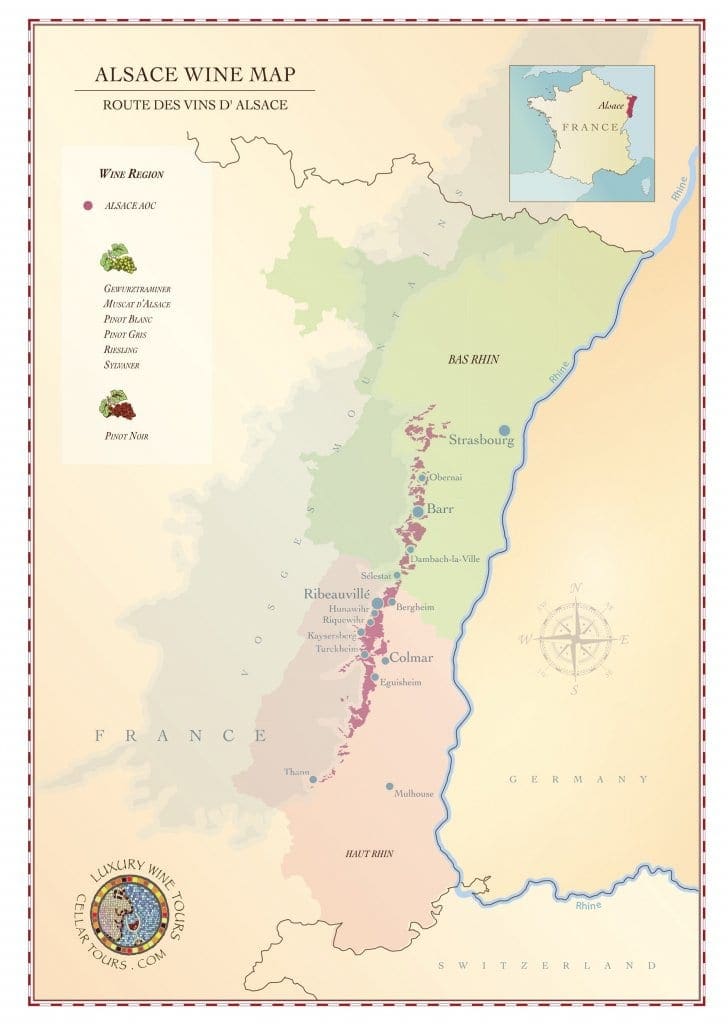
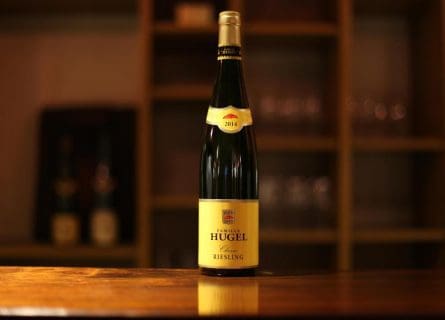
The Alsatians continue to maintain heterodox views on the importance of varietal labeling. Alsace breaks the mold with a “New World” philosophy. Here, grape varieties (displayed prominently on labels) take center stage, unlike Burgundy, where brand or terroir reign supreme. This emphasis on grape variety might seem sacrilegious to Burgundians.
However, Alsace makes up for it with its renowned consistency in quality. Although there are some substantial merchant operations and large wine co-operatives in the region, generally, the area is not a bulk wine creator. In every sense of the word, Alsace is unique among French vineyards.
Dry Riesling: Alsace’s Signature Elegance
Today, Alsace continues to produce a wide range of styles. These include traditional method sparkling, excellent rosé, fragrant Pinot Noir, and late-harvest or ‘Vendage Tardive’ dessert wine. Yet, for most consumers, Alsace is France’s premier source of dry Riesling.
Historically, winemaking dynasties like the Hugel family would vinify their wines in large wooden casks. Fermentation temperatures would often climb above 75 Fahrenheit in their ancient cellars. Such an approach has its merits: it produces a very dry, steely expression of the Riesling grape, gaining complexity as it ages. Yet higher temperatures will inevitably burn out many of the aromatic compounds and fruity esters contained in the must.
Pinot Noir’s Allure
Mindful of contemporary expectations, some houses now ferment their wines in stainless steel at precisely controlled temperatures. This creates a very aromatic and fruit-forward style. Winemakers often treat other key varieties, like Pinot Gris and Gewurztraminer, similarly. As a rule, the Alsatian approach is to eschew oak maturation; producers want fruit expression at the forefront of their wines.
But there are exceptions: Pinot Noir and its white cousin can benefit from time in barrique. The former is now one of Alsace’s best sellers and a reliable alternative to red Burgundy.
Crémant d’Alsace: A Sparkling Gem with a Unique Identity
Crémant d’Alsace (the designation for local bubbly) is another highlight. The law mandates production through the traditional method, which involves a secondary fermentation in the bottle. This is the same way Champagne is made. However, growers work with a very different palette of grape varieties. These include Pinot Blanc, Silvaner, Pinot Gris, Riesling, Chasselas, and Auxerrois Blanc.Thus, the result tastes nothing like Champagne: Crémant d’Alsace is more pungent and fruity, with less autolytic complexity.
Critics and buyers, however, regard top Crémant Rosé as equal to pink Champagne. It is always a 100% Pinot Noir style, made using the maceration method. Expect a cornucopia of red berry fruits and brilliant acidity – the ultimate summer aperitif. Unfortunately, the secret is out, and demand now outstrips supply.
Meanwhile, Alsace’s late-harvested dessert wines remain critically lauded, although global demand has slumped in recent years. The Vendage Tardive (VT) and Selection de Grains Nobles (SGN) wines, produced by leading estates, can rival top Sauternes in elegance. They offer remarkable depth and exceptional balance.
Discover more about Alsace Wine Classifications
Alsace has spent the last twenty-five years promoting its superlative wines to the world. Demand in the domestic market has always been relatively strong. Despite buoyant tourism, Bordeaux and Burgundy overshadowed Alsace for most of the 20th century. Unlike its rivals, this complex region did not overall appeal to wealthy collectors and connoisseurs.
The upside is incredible value across the board. Alsace, despite offering an array of unique flavors and complex wines, remains underpriced for the quality it delivers. But, as exports continue to rise, more and more consumers are discovering just how magnificent Alsatian wine can be. This is increasingly essential, as younger French drinkers appear to be moving away from wine towards puritanical absenteeism – or seeking alternatives like beer and spirits.
Alsace’s Historical Position in the Wine Industry
Approximately 25% of the region’s annual production is sent abroad today: Scandinavia, the UK, and the US are key export markets. Alsace’s major advantage is the unprecedented global popularity of saline dry whites: Pinot Gris, Silvaner, and Pinot Blanc are three on-trend varieties that suit wine bars – and upmarket retailers – down to the ground. However, the region’s signature white style remains unfashionable despite the best efforts of critics, influencers, and buyers. For the moment, Riesling has yet to catch fire in the US, although niche demand is steady. Nevertheless, there is more work to be done here.
The Global Rise of Alsace Wines
Yet Crémant d’Alsace is on a roll. Alsace production of this underrated bubbly boomed from just over 3 million bottles in 1985 to over 32 million bottles today, and it’s still on the rise. The catalyst for this growth is changing attitudes to sparkling wine; consumers no longer limit their enjoyment to ‘special occasions.’ Today, an affordable bottle of premium fizz is a weekend treat, and Crémant d’Alsace delivers precisely what Millennials want: quality and value for money.
Peter Doherty, a leading wine buyer based in London, says:
“Dopff Au Moulin (a leading brand of Crémant d’Alsace) has performed extremely well over the past year, in all UK markets – a testament to the wines they produce. We have found our hospitality customers often use Crémant as an alternative to Prosecco and many establishments will serve it by the glass as it sits at a lower price point and doesn’t compete with Champagne,” He continues: “Whilst there will be differences in style, in the mind of the consumer the name Crémant invokes a good or high-quality sparkling wine made using the traditional method that is similar to Champagne, but not as expensive.”
Crémant d’Alsace’s Growing Popularity
Currently, if you look at the major supermarkets, Crémant sits either at around the same price level or slightly above Prosecco. In the current economic climate, with high levels of inflation, consumer bills going up, and real wages decreasing, consumers will be looking even more for wines that have a great price-to-quality ratio (which we are already seeing in the on-trade).
This creates a great opportunity for Crémant to increase its market share of the sparkling category as its price point is fantastic for the quality of wine you receive.” Thus, what was once a minor player in Alsatian wine has become an area of major commercial importance. Modern Alsace produces wines for those who collect unique tastes and don’t demand blockbusters. Crémant d’Alsace, delicious and affordable, is becoming a poster child for this historic vineyard’s renewed confidence and swagger. Long may it continue.
Discover Riesling's charm, a white grape from Germany's Rhine region, cherished in Alsace, France. Unveil its secrets and delights
Find out morePinot Gris is a white-wine grape variety originally from Burgundy. It is thought to be a mutant clone of Pinot Noir.
Find out morePinot blanc is a white wine grape varietal, that is a mutation of Pinot noir grape. It is planted in mostly Alsace, Germany and Northern Italy.
Find out moreExplore Gewurztraminer, a highly aromatic white grape from Alsace, France. Savor its unique character and allure in every sip
Find out moreMuscat blanc is a white wine grape varietal popular in the Muscat d'Alsace, Moscato d'Asti and Beaumes-de-Venise regions.
Find out morePinot noir is a light-bodied red wine varietal closely related to the Vitis vinifera grape and produces the most sought-after red wines in the world.
Find out more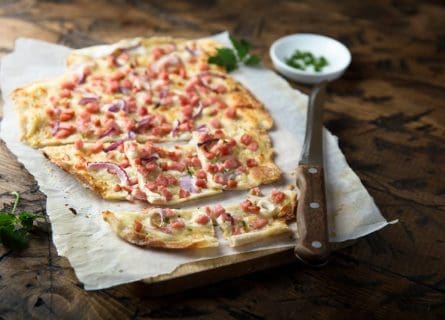
The variety of places in Alsace that offer a fine meal is enormous. Throughout the day, the ubiquitous cafes that fill every town and village are ideal for a coffee and snack. Colmar’s medieval streets are full of these charming institutions, surrounded by pastel-colored houses. But for something more substantial, seek out the region’s many excellent bistros, brasseries, and restaurants; Alsatian cuisine is rich, hearty, and immensely satisfying.
Suffice it to say, one can detect Germanic influences in many regional classics, including the choucroute alsacienne: juniper-flavored sauerkraut paired with hot sausage, bacon, pork, and ham knuckle. Visitors swoon over fresh Flammekuche, a rectangular pizza topped with crème fraîche, thinly sliced raw onions, and lardons or small bacon strips. They also adore the delicious Coq au Riesling. Think of it as an Alsatian facsimile of Burgundy’s Coq au Vin.
Guide to Gastronomy for Alsace: Read more.
If you would like us to customize an exclusive luxury tour, contact us and let us know your travel plans. We offer luxury food and wine tours for private groups of a minimum two guests. In addition, all of our private, chauffeured tours are available year-round upon request.

